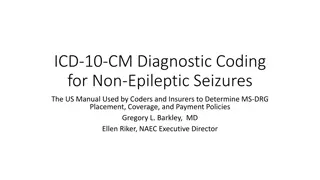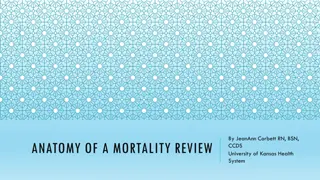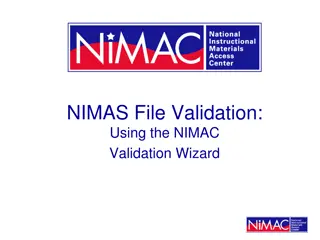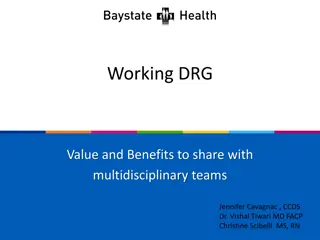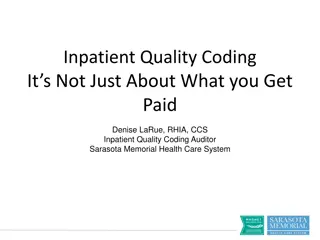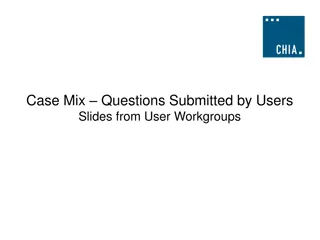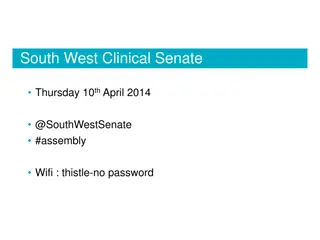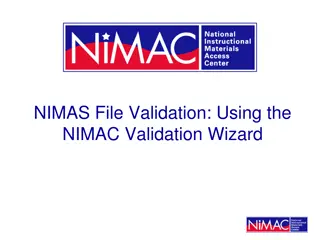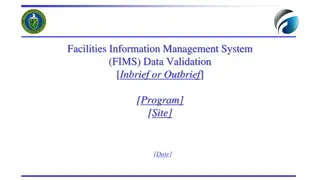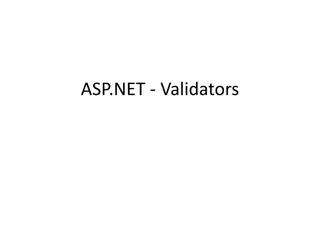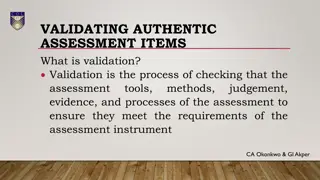Understanding Clinical Validation and DRG Validation in Healthcare
Clinical validation ensures that diagnoses documented in a patient's record align with accepted clinical criteria, while DRG validation focuses on matching hospital-coded information with physician descriptions and patient records. Clinical validation involves a review by clinicians to confirm the patient's conditions, beyond the scope of coding validation. Both processes play vital roles in accurate healthcare documentation and billing practices.
Download Presentation

Please find below an Image/Link to download the presentation.
The content on the website is provided AS IS for your information and personal use only. It may not be sold, licensed, or shared on other websites without obtaining consent from the author. Download presentation by click this link. If you encounter any issues during the download, it is possible that the publisher has removed the file from their server.
E N D
Presentation Transcript
Clinical Validation Angela Maxfield, Elisa Sninchak and M.E. VanGelder 1
ICD 10CM Guideline for Coding and Reporting in 2017 I.A. 19 Code Assignment and Clinical Criteria The ICD-10-CM Official Guidelines for Coding and Reporting for 2017 state: The assignment of a diagnosis code is based on the provider s diagnostic statement that the condition exists. The provider s statement that the patient has a particular condition is sufficient. Code assignment is not based on clinical criteria used by the provider to establish the diagnosis. 2
ICD 10CM Guideline for Coding and Reporting in 2017 I.A. 19 Code Assignment and Clinical Criteria The problem: Some people were interpreting this to mean that clinical documentation improvement (CDI) specialists should no longer question diagnostic statements that don't meet clinical criteria. But is this true? 3
Clinical Validation Definition Clinical validation means that diagnoses documented in a patient's record must be substantiated by clinical criteria generally accepted by the medical community. Generally accepted clinical criteria typically come from authoritative professional guidelines, consensus, or evidence- based sources. Q. Would other providers come to the same conclusion based on the same information? 4
Clinical Validation defined by CMS CMS definition of clinical validation was noted in 2013 Recovery Audit Contractors, Scope of Work document cited in the AHIMA Practice Brief ("Clinical Validation: The Next Level of CDI") and published in JAHIMA August 2016: "Clinical validation is an additional process that may be performed along with DRG validation. Clinical validation involves a clinical review of the case to see whether or not the patient truly possesses the conditions that were documented in the medical record. Clinical validation is performed by a clinician (RN, CMD, or therapist). Clinical validation is beyond the scope of DRG (coding) validation, and the skills of a certified coder. This type of review can only be performed by a clinician or may be performed by a clinician with approved coding credentials. Clinical validation should be done side by side with DRG validation. 5
DRG Validation Definition The purpose of DRG validation is to ensure that diagnostic and procedural information and the discharge status of the beneficiary, as coded and reported by the hospital on its claim, matches both the attending physician's description and the information contained in the beneficiary's medical record. Reviewers shall validate principal diagnosis, secondary diagnoses and procedures affecting or potentially affecting the DRG.(1) (1) CMS Manual System, Department of Health & Human Services (DHHS), Pub 100-08 Medicare Program Integrity 6
Taking Coding to the Next Level Through Clinical Validation -It has never been reasonable or compliant for a coder to infer a medical condition from clinical indicators -Nor is it reasonable for a coder to decide a condition doesn t exist if the provider has documented it Per CMS Clinical validation involves a clinical review of the case to see whether or not the patient truly possesses the conditions that were documented in the medical record. Clinical validation is essential before codes can be assigned and submitted on claims RAC auditors perform DRG validation to identify coding errors. A significant amount of claims have an incorrect PDX. AHA Coding Clinic 4th quarter 2016, pg 147 Clinical validation is beyond the scope of DRG (coding) validation, and the skills of a certified coder. This type of review can only be performed by a clinician or may be performed by a clinician with approved coding credentials Reference: CMS MLN Matters SE 1121, 2013 7
AHIMA Published Clinical Validation Advice in July 2016 Based on CMS guidance and the Coding Clinic referenced it appears clinical validation may be most appropriate under the purview of a CDI Specialist with a clinical background or approved coding credentials The goal of clinical validation is to ensure the EMR is accurately coded and reflects the true clinical picture of the patient; which requires collaboration with providers, CDI, coders and quality Reference: "Clinical Validation: The Next Level of CDI" Journal of AHIMA 87, no.7 (July 2016) 8
ACDIS CDI Journal Article : Clinical Validation and Coding Audits Jocelyn E. Murray RN, CCDS penned a column for the Nov/Dec 2017 CDI Journal. She wrote: Coding audits enable facilities to identify opportunities to improve code assignment and compliance with CMS guidelines. CDI audits identify chances for enhanced queries and missed opportunities. Both are needed to ensure our medical records are complete and accurate. 9
ACDIS CDI Journal Article: Clinical Validation and Coding Audits She concluded the column by saying: The blended model of CDI and coding audits promotes the highest documentation integrity and coding accuracy for inpatient and outpatient practices. Access to both resources and a defined process provides return on investment in patient safety and resources for care. 10
Some of the Most Common Clinical Validation Denials AKI, Malnutrition, PNA, UTI, Sepsis, Encephalopathy and Respiratory Failure Reasons why diagnoses are susceptible targets for denials: Removal of CC/MCC downgrades the DRG Empiric treatment for diagnosis with no source of infection identified, but diagnosis continues to be copied and pasted, so it gets coded Not documenting ruled in, ruled out, resolved, and recapping the diagnosis in the D/C Summary A solitary mention of a diagnosis- (this should solicit a query to determine whether the condition was present) Not being current or aware of established clinical guidelines. Clinical guidelines do change, such as Sepsis and Malnutrition. If a guideline is not universally adopted, variability is allowed within the standard acceptable range of practice. CDI Strategies Dec issue reported coding kwashiorkor resulted in more than $6M in over payment according to OIG report. OIG blamed discrepancy between the tabular list and alphabetical index OIG recommended hospitals refund the overpayments and strengthen controls to ensure compliance 11
Programs Without A Clinical Validation Process Programs without an established Clinical Validation process should have an intense provider education program. Professional relationships between CDI and providers are essential Verbal conversations and verbal queries are sometimes best in difficult to explain gaps in documentation. This, of course, must be followed up by a written query in the chart, and follow the same query guidelines as a written query. CDI should have continued education discussions, both formal and informal, regarding the importance of documentation to support diagnoses. 12
Encephalopathy Elderly female admitted after a fall with fx femur. Has a caregiver who was present at bedside. Patient described the fall to the ER provider, and was noted to be AAOx3 on arrival. No recent illness, no h/o dementia. Patient was participating in discharge planning conversation with Case Management. H/P: Fx R Femur, Encephalopathy POA, Afib, CHF, CAD. Day 2 progress note state Encephalopathy - POA, now resolved. 13
Importance of Clinical Validation of Diagnoses A clinical validation is needed to get the clinical indicators in the chart to support the diagnosis of encephalopathy . No documented supporting evidence of encephalopathy or reason for encephalopathy. Allows for a diagnosis to be attached to the patient without any clinical support. It s the only mcc on the record. Potential for denial of claim. Potential for RAC audit. 14
Compliant Query Practice 1. In a situation where the provider s documented diagnosis does not appear to be supported by clinical findings, ask yourself: Does the diagnosis meet the criteria for a secondary diagnosis? The Official Guidelines for Coding and Reporting define an additional diagnosis as one which: affects patient care in terms of requiring: clinical evaluation; or therapeutic treatment; or diagnostic procedures; or extended length of hospital stays; or increased nursing care and/or monitoring. What clinical indicators are documented to support the diagnosis? Include patient presentation, symptoms, complaints, lab results, diagnostic studies, ordered treatments and interventions, monitoring/assessments present in medical record, in nursing notes and auxiliary staff notes 15
Compliant Query Practice 2. Query the provider for clinical validation of the diagnosis. Queries should be used to support the criteria for quality documentation: legibility, completeness, clarity, consistency, and precision in the EMR. A certified coder who has identified a diagnosis which needs more clinical support does not have the ability to validate it, but they do have the skills to recognize the necessity for validation. (program with a concurrent coder) A CDI Specialist is the clinician or individual with the appropriate credentials to generate a clinical validation query. The physician is the one who performs the validation by responding to the query in the affirmative and providing the clinical evidence they relied upon to make the diagnosis in question. *** Absence of abnormal clinical indicators does not mean the condition is not present; it means the encounter needs clinical review and the condition may require more provider documentation to support the diagnosis. 16
DRG Denial for Sepsis and Acute Respiratory Failure Payer Denial letter from UHC for DRG 871 17
DRG Denial for Sepsis and Acute Respiratory Failure Payer recommended DRG 194 - simple PNA w CC -$5,200 18
Lack of Clinical Indicators for Sepsis Payer letter stated DRG reassigned due to: No clinical indicators supporting sepsis dx ED VS: T 100.9, BP 188/96, P 88, R 16, Labs: WBC 16 CXR: RML and RLL infiltrates Meds: IV Abx for PNA No hypotension, thrombocytopenia, AMS 19
Lack of Clinical Indicators for Acute Respiratory Failure Payer letter stated DRG reassigned due to: No clinical indicators supporting acute resp failure ED VS: T 100.9, BP 188/96, P 88, R 16 Given O2 in triage, O2 sat 92% No ABG s Acute resp failure in COPD implies a 10-15 mmHG decrease in baseline PO2. No adult respiratory distress syndrome PDX is PNA 20
DRG Denial for Sepsis and Acute Respiratory Failure Appeal letter written to dispute DRG 194: Agreed sepsis could not be supported Positive blood cultures but reported suggestive of contamination at time of collection Patient had temp x2 but did not exceed 101F Lactic acid 1.0, procalcitonin WNL 21
DRG Denial for Sepsis and Acute Respiratory Failure Agreed acute resp failure couldn t be supported Patient had underlying COPD w PNA 4L O2 given during stay with O2 sats 93-95% Respiratory failure not stated in DC Summary Appealed for final DRG 190 - COPD w MCC Third quarter coding clinic 2016 states COPD w acute lower resp infection must be sequence first as PDX, PNA assigned as additional diagnosis 22
Appealed for DRG 190 +$1,300 23
Takeaway Following Review For DRG Denial Need for clinical validation query Sepsis PN stated Sepsis 2/2 to PNA - Blood cultures positive. Low Procalcitonin may suggest this is a contaminant, lactate 1.0 Acute respiratory failure PN mentioned Hypoxic respiratory failure 2/2 COPD exacerbation: 2/2 to PNA. Wheezing. States has been on oxygen before, but not now. 2L O2, 95% sat 24
Takeaway Following Review For DRG Denial Need to remind providers about the importance of continued documentation Patient initially admitted to the ICU with diagnoses of Sepsis due to Pneumonia & Acute Respiratory Failure When patient was stable for transfer to the floor, the hospitalist documented Pneumonia and shortness of breath - resolved The insurance company made the argument that both Sepsis and Acute Respiratory Failure were ruled out since they were not propagated throughout the progress notes and discharge summary, meaning they should not have been coded The correct way for the hospitalist to document this scenario: 1. Sepsis, due to pneumonia - resolved 2. Acute Respiratory Failure, due to pneumonia - resolved 3. Pneumonia Continue current antibiotic regime Brundage Medical Group. (2017). Documentation tip of the week: Documentation continuity. Retrieved from, www.BrundageMedicalGroup.com 25
ACDIS Suggested Clinical Validation Query Format Please clarify the status of sepsis: Sepsis was Confirmed/ include supporting rationale Sepsis was Ruled out Sepsis was without clinical significance Unable to determine Other ______________ Please clarify the status and type of acute respiratory failure: Documented diagnosis of Acute Respiratory Failure is support by: (please document clinical indicators/treatment) Other diagnosis (please document) Acute Respiratory Failure was ruled out After study this diagnosis was no longer valid Unable to clinically determine (please explain) 26
Clinical Validation of POA Status Include validation of Present on Admission status with each review and to confirm accuracy of all POA indicators during final DRG reconciliation. 27
Unanswered Query Escalation Policy Purpose: CMS recommends that each facility develop an escalation process for unanswered queries. The purpose of this policy is to define the process for escalation of Clinical Documentation Improvement Queries. 1. It is appropriate to query for documentation clarification in the following situations per The AHIMA Practice Brief: a. When there are clinical indicators of a diagnosis, but no documentation of that diagnosis b. Clinical evidence for a higher degree of specificity or severity c. A cause and effect relationship between two conditions or organisms 30
Unanswered Query Escalation Policy d. An underlying cause when documenting symptoms only e. Present on admissions status of a diagnosis f. A diagnosis is provided without the underlying clinical validation 2. It is also appropriate to query the physician when the documentation in the medical record fails to meet any one of the following criteria: a. Legibility b. Completeness c. Clarity d. Consistency e. Precision 31
Unanswered Query Escalation Policy Policy: 1. If the query is unanswered within 48hr business hours of posting on either the electronic query form, in the progress note or discharge summary, the Clinical Documentation Specialist will send an a notification to the appropriate physician through either the CDI review section of EPIC in basket messaging system, and/or via the preferred method of facility. If the query is not answered after the notification has been sent, the Clinical Documentation Specialist will continue to attempt to follow up with queried physician via phone calls, PHI secure texting systems, or face to face contact. All attempts to contact the queried physician, including date and type of contact, will be documented in the current CDI data system. 2. 32
Unanswered Query Escalation Policy 3. If after several attempts, the query continues to be unanswered the CDI will forward the case to the CDI manager who will determine if the case needs to be escalate it to the facilities CMO. 4. If the query is not answered at discharge the CDI will review the medical record, including the discharge summary to determine if the query has been answered and/or if there is a continued need for the query clarification. If there is a continued need for the query clarification the CDI will follow the steps outlined above. 33
Unanswered Query Escalation Policy 5. When there is identified a pattern of a physician documenting unsupported diagnoses, after clinical validation queries have been issued, the CDI will forward that information to the CDI manager for review. The CDI manager will determine if this physician s cases need to be forwarded to the CMO or physician advisor for evaluation and appropriated follow up, if warranted. 34
Concluding Thought **Clinical Validation Should Be Driven by CDI Queries to Reduce Your Risk for Denials** Angela Maxfield, Elisa Sninchak and M.E. VanGelder 35
References ACDIS. (2015, September 24). Query: Clinical validation for respiratory failure diagnosis. ACDIS. (2017, December 7). News: Coding kwashiorkor resulted in more than six million in overpayment. CDI Strategies, vol. 11, issue 56. Retrieved from, https://acdis.org/articles/news-coding-kwashiorkor- resulted-more-six-million-overpayments-oig-says ACDIS Blog. (2013, August 22). Q&A: Querying for clinical validation of a diagnosis. ACDIS Blog. (2017, March 3). Note from the instructor: Increase understanding of pathophysiological concepts for CDI. AHIMA. (2016, July). Clinical Validation: The Next Level of CDI. Journal of AHIMA 87, no.7. Retrieved from, http://www.ahimajournal- digital.com/ahimajournal/july_2016?pg=57#pg57 36
References AHIMA Practice Brief. (Updated 2016, January). Guideline for achieving a compliant query practice. Brundage Medical Group. (2017). Documentation tip of the week: Documentation continuity. Retrieved from, www.BrundageMedicalGroup.com Centers for Medicare and Medicaid Services. (2012, July 31). Recovery Audit Program DRG Coding Vulnerabilities for Inpatient Hospitals. MLN Matters: SE 1121. KDIGO Clinical Practice for Acute Kidney Injury. (2012, March). Official Journal of the International Society of Nephrology. Retrieved from, http://www.kdigo.org/clinical_practice_guidelines/pdf/KDIGO%20AKI%20Guideline.pdf Landon, Lee A. (2017, November 27). Escalation policy: Unanswered queries.ACDIS. Retrieved from, https://acdis.org/resources/escalation-policy-unanswered-queries Murray, Jocelyn E. (2017, November/December). CDI clinical validation and coding audits. CDI Journal, vol. 11, issue 6, pg. 11. Retrieved from, https://acdis.org/articles/download- novemberdecember-edition-cdi-journal 37
References Pinson, R.D., Tang, C.L. (2016, December). What is clinical validation? ACP Hospitalist. Retrieved from, https://www.acphospitalist.org/archives/2016/12/coding-clinical- validation.htm Pinson, R.D., Tang, C.L. 2017 CDI pocket guide. Brentwood, TN: HCPro. Remer, E.R. (2017, February 22). Implementing thorough documentation, queries to drive clinical validity. Just Coding Inpatient. Retrieved from, https://justcoding.com/articles/implementing- thorough-documentation-queries-drive-clinical-validity Weygandt, P. (2010, April 21). DRG Validation Plowing New Ground: Intrusions into the practice of medicine.RAC Monitor. Retrieved from, https://www.racmonitor.com/drg-validation-plowing-new-ground- intrusions-into-the-practice-of-medicine 38



